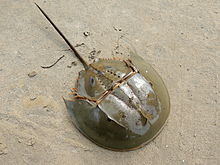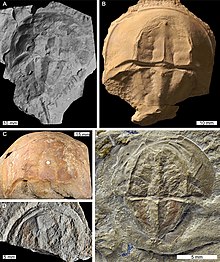
Back سرطان حدوة الحصان Arabic سرطان حدوة الحصان ARZ لیمولیده AZB লিমুলাস Bengali/Bangla Limúlids Catalan Háu CDO Limulidae CEB Dolkhale Danish Pfeilschwanzkrebse German Hufumkraboj Esperanto
| Limulidae Temporal range:
| |
|---|---|

| |
| Tachypleus gigas, one of the four extant species | |

| |
| Jurassic-aged limulids. Crenatolimulus (A,B), Limulus (C), Mesolimulus (D,E) | |
| Scientific classification | |
| Domain: | Eukaryota |
| Kingdom: | Animalia |
| Phylum: | Arthropoda |
| Subphylum: | Chelicerata |
| Order: | Xiphosura |
| Superfamily: | Limuloidea |
| Family: | Limulidae Leach, 1819[1][2] |
| Genera | |
|
See text | |
Horseshoe crabs are arthropods of the family Limulidae and are the only surviving xiphosurans. Despite their name, they are not true crabs or crustaceans. Rather, they are chelicerates. This makes them more closely related to arachnids like spiders, ticks, and scorpions. The body of a horseshoe crab is divided into three main parts: the cephalothorax, abdomen, and telson. The largest of these, the cephalothorax, houses the majority of the animal's eyes, limbs, and internal organs. It's also where the animal gets its name, as its shape somewhat resembles that of a horseshoe. Horseshoe crabs have changed little in appearance since they first evolved, earning them the title of "living fossil".
Only four species of horseshoe crab are alive today, with most of them being marine. This contrasts with the lifestyle of extinct members, as some transitioned to living in freshwater. Horseshoe crabs are primarily benthic animals but can swim if needed. In the modern day, their distribution is somewhat limited, only being found along the east coasts of North America and southern Asia.
Horseshoe crabs are occasionally used as fishing bait, but they are also eaten as a delicacy in some parts of Asia. More commonly, horseshoe crabs are caught for their blood, something valuable to the medical industry. The blood's usefulness comes from the Limulus amebocyte lysate, a chemical in used to detect bacterial endotoxins. In recent years, these animals have experienced a population decline. This is mainly due to coastal habitat destruction and overharvesting.
- ^ Sekiguchi K (1988). Biology of Horseshoe Crabs. Science House. ISBN 978-4-915572-25-8.
- ^ "Limulidae Leach, 1819". World Register of Marine Species. Flanders Marine Institute. 2023. Archived from the original on 26 April 2023. Retrieved 17 January 2023.
© MMXXIII Rich X Search. We shall prevail. All rights reserved. Rich X Search